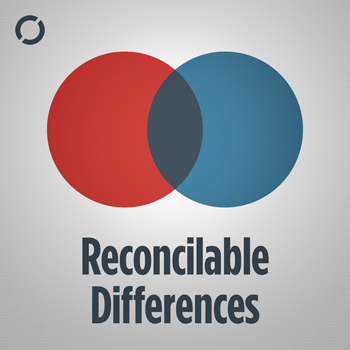Support this show
Get an ad-free version of the show, plus a monthly extended episode.#158: Wait for the Wave
June 11th, 2021 · 136 minutes
As a main topic this week, your hosts discuss Theme Dining Nights. Why can't more experiences be like John's old deli? Differences regarding leftovers are, unfortunately, not reconciled.
This episode of Reconcilable Differences is sponsored by:
- Squarespace: Make your next move. Enter offer code DIFFS at checkout to get 10% off your first purchase.
- Burrow: Get $75 off your Burrow purchase—plus, fast & free shipping.
- Instabug: Ship Quality Apps with Real-Time Contextual Insights
Stream this episode
Links and Show Notes
This week kicks off with Merlin offering a heartfelt thank you to John for helping him know where he is. John shouldn't need to wiggle, and Merlin can't imagine ever asking for the return of "contact." Your hosts agree accessibility is good for everybody.
John has updates on drama in the NES Tetris Scene, and Merlin remembers bringing a pencil to the arcade so he could cheat. John repurposes an excellent graphic by Neven to ask how buttony a button needs to be to look like it's a button. This leads to a surprisingly interesting mini-dive into practical UX and ways that an affordance can let you know that it's an affordance.
John's worries that his dispose-all may be starving to death.
(Recorded on Tuesday, June 1, 2021)
Credits
- Audio Editor: Jim Metzendorf
- Admin Assistance: Kerry Provenzano
- Music: Merlin Mann
- The Suits: Stephen Hackett, Myke Hurley
Increase Apple TV screen contrast - Apple Support
Jigsaw puzzle glossary – Cloudberries
In The Unlikely Event - 99% Invisible
Trying Everything on the Menu at an Iconic NYC Restaurant - YouTube
NES Tetris "Rolling" technique
How "button-y" is your button?
It Takes Two - PlayStation game
LG G1 vs. Sony A90J - YouTube
Pink tint off-axis on LG G1 (starts at 8:21) - YouTube
HDMI Cables: Types and Specifications Explained
Putting a Bolder Face on Google - The New York Times
Her decision was diplomatic, but it also amounted to relying on her gut rather than research. Since then, she said, she has asked her team to test the 41 gradations between the competing blues to see which ones consumers might prefer.
ATP 432: I Shouldn't Need to Wiggle — Accidental Tech Podcast
Compacted sugar, Jade theories, TV-remote button feel, and looking — but not reaching! — very far upward.
What are Affordances? | Interaction Design Foundation (IxDF)
Affordances are properties of objects which show users the actions they can take. Users should be able to perceive affordances without having to consider how to use the items. For instance, a button can be designed to look as if it needs to be turned or pushed.
Button-mashing classic Track & Field returns on PS4 and Nintendo Switch – Destructoid
Track & Field is notorious for its button-mashing ways, and has built many legends around the methods used by ’80s kids to get high scores, from having a third hand help out, to the game’s notorious “pencil trick” which saw players see-saw a pencil between their fingers for knuckle-crushing, high-scoring action… Ahh, the suffering we went through just to become number one.
